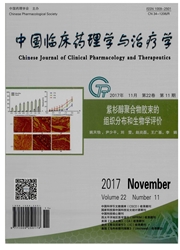

 中文摘要:
中文摘要:
目的:研究血管紧张素转化酶(angiotensinconverting enzyme,ACE)基因多态性与依那普利降压疗效的相关性。方法:采用聚合酶链式反应一限制性片断长度多态性(polymerase chain reaction-restriction fragment length polymorphism,PCR—RFLP)对68例原发性高血压患者进行ACE基因型分析,根据ACE三种基因型DD型、ID型和Ⅱ型将受试者分为三纽,所有受试者每天服用依那普利20mg进行2周的降压治疗,观察依那普利在三种不同ACE基因型中的降压疗效及差异。结果:在所有68例原发性高血压患者中,依那普利治疗前与治疗后每组SBP和DBP的降低均有统计学意义(P〈0.05),其中DD型与Ⅱ型两组之间的SBP和DBP降压幅度(即治疗前与治疗后血压的差值)有统计学意义(P〈0.05)。DD型组依那普利的总有效率为91.30%,ID型组为85.71%,Ⅱ型组是79.16%。结论:原发性高血压患者中ACE基因多态性与依那普利降压疗效相关。
 英文摘要:
英文摘要:
AIM: To investigate the relationship between the therapeutic effect of enalapril on blood pressure reduction and ACE genetic polymorphisms. METHODS: The genotypes of ACE in 68 patients with essential hypertension were determined by polymerase chain reaction-restriction fragment length polymorphism (PCR-RFLP) assay. All subjects were randomly divided into three groups ( group DD, group Ⅱ, and group ID) according to their different ACE genotypes. 68 patients with essential hypertension were treated with 20 mg enalapril daily for 2 consecutive weeks. The changes of systolic and diastolic blood pressure in all subjects were observed before and after enalapril administration. RESULTS: The data showed that there were significantly statistical difference in the systolic blood pressure and diastolic blood pressure in three groups' patients with essential hypertension between before and after enalapril administration ( P 〈0.05). Additionally, there was marked difference in the differential values of systolic blood pressure and diastolic blood pressure reduction between group DD and group Ⅱ ( P 〈 0.05). The total efiqcacy rate of enalapril treatment was 91.30 % in group DD, 85.71% in group ID, and 79.16% in group Ⅱ respectively, which indicated enalapril had the best effect on blood pressure reduction in DD genotyped group. CONCLUSION: The therapeutic effect of enalapril on blood pressure reduction is associated with ACE genetic polymorphism and the essential hypertensive patients with DD genotypes had the best response to enalapril treatment compared with ID genotypes and Ⅱ genotypes.
 同期刊论文项目
同期刊论文项目
 同项目期刊论文
同项目期刊论文
 Trp64Arg polymorphism of beta 3-AR and Gln27Glu polymorphism of the beta 2-AR are associated with ob
Trp64Arg polymorphism of beta 3-AR and Gln27Glu polymorphism of the beta 2-AR are associated with ob Association of eIF3 p170 expression with chemotherapy response of lung cancer and its effects on cis
Association of eIF3 p170 expression with chemotherapy response of lung cancer and its effects on cis Impact of rosiglitazone on the expression of beta(3)-AR in the stable cell lines expressed beta(3)-A
Impact of rosiglitazone on the expression of beta(3)-AR in the stable cell lines expressed beta(3)-A 期刊信息
期刊信息
